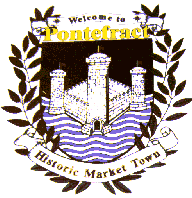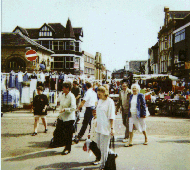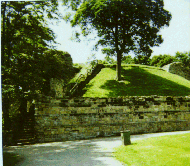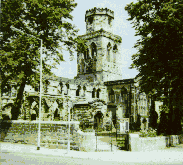
(Longtitude 169 Latitude 17)

 |
The construction of the M62 and its link to the A1 has finally put Pontefract on two main routes. Retail and light engineering developments have followed. The population of Pontefract is now about 35,000 and the attraction of this historic town continues to draw visitors from the surrounding area especially on market days & due to its variety of attractions within the local vicinity. |
| HomePages | Rachel Byass | David Wilks | Stuart Lonsdale | ||
| Businesses | BeachTree Ceramics | Restaurants | Helicopters | ||
| Places To Visit | Museum | Castle | Hermitage | Valley Gardens | Park |
| Hotels | Tudor Guest House | Parkside Hotel | |||
| Schools | Kings High | Carleton High | New College | ||
| Information | P&C Express | NewsLetter | Evening Post | Hospital | www.ponte.co.uk |
| Sports | Golf | Horse Racing |
| Pontefract's heyday however was in the Middle Ages, though there had been prehistoric and Roman settlements of the area. Soon after the Conquest in 1066, a castle was built by the occupying Norman armies on a spur of rock to the East of the present town centre. The original wooden fortification was a motte and bailey castle on a man-made hill on the top of the ridge. It would have loooked similar to Clifford's Tower at York. The Castle held sway over extensive lands, including Leeds, Bradford and over towards Huddersfield. |  |
| Pontefract Castle later passed into royal ownership and this stimulated the growth of the existing settlements of Kirby and Tanshelf on either side of the Castle. The Castle was used to hold political prisoners, becoming notorious as 'Bloody Pomfret' in Shakespear play, Richard II. Charles, Duke of Orleans, Thomas of Lancaster and Richard II were all held at Pontefract Castle, with the last two both being executed there. |
| It is difficult to imagine from the present size of the town and its remaining buildings, the important part Pontefract played in the political and religious life of Britain in the Middle Ages. As well as the King's Court, Pontefract attracted many religious houses, including a monastery the size and appearance of Selby Abbey. A hermitage was dug 51 feet into the rock and can still be seen today. The hermit, Peter of Pomfret, lives on in Shakespear's play King John. To the North of the Castle, the site of Thomas of Lancaster's execution became a place of pilgrimage. |
| It is likely that liquorice was first brought back to Pontefract from the Middle East during the Crusades. At first it was grown as a medical plant; the first sweets date back from the seventeenth century. |
| Henry VII's dispute with Rome resulted in the dissolution of the monasteries and Pontefract's priory and other monastic houses were demolished. Pontefract Castle was a focal point for the Pilgramage of Grace, the revolt of the northern counties against Henry VIII's religious changes and economic impositions. |
| By the Seventeenth century, Pontefract castle had grown into the imposing stucture depicted by Kierinx in the painting which now hangs in Pontefract Museum. When Civil War broke out, Pontefract castle remained a royalist stronghold and was reputed to have been the last to fall to Cromwell's armies. |
 |
During the sieges of Pontefract castle, rough coins were struck to pay the troops. Following the execution of Charles I, the royalist motto became 'AFTER THE DEATH OF THE FATHER, WE ARE FOR THE SON' and this remains the motto of the town today. Though the castle was damaged during the fighting, it was a petition from the townspeople to Parliament which resulted in its demolition. the ancient church of All Saints was ruined by the Civil War but is still an interesting building, with a rare double helix staircase to the tower. |
| In the Middle Ages Pontefract was the main centre of West Yorkshire. By the eighteenth century its regional economic significance had declined but it was still a prosperous town. |
| The great North Road (later the A1) bypassed Pontefract as the Roman roads had done before. Ferrybridge, the crossing point for the River Aire, became important for stage coaches and postal services as Castleford must have been in Roman times. The advent of the railway companies failed to improve Pontefract's position on the communication network as two lines and three stations were built instead of a single linking point. |
| In 1872 Pontefract was in the National limelight when the Pontefract by-election used the secret ballot system or the first time in Britain. As the nineteenth century progressed the town expanded with the growth of liquorice sweet-making,the coming of coal and the stationing of two regiments in permanent barracks. Between 1871 and 1931 the population of Pontefract tripled as a result of these developments, together with the growth in sand quarrying, cast-ironmaking, maltings and skinyards. |
| Racing at Pontefract was first recorded in the 1720's and regular races were organised by the turn of the century. The grandstand was erected in 1802 and in 1983 Pontefract racecourse became the longest continous flat racing course in Europe. |  |
![]()